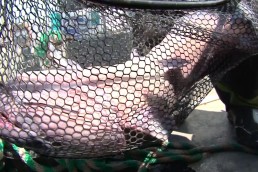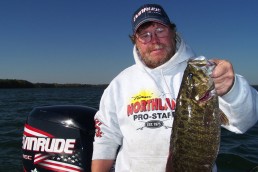Fish Sense: Appealing to Sight, Sound and Scent
SHARE THIS POST
Catching fish requires appealing to the senses
It’s common knowledge that largemouth and smallmouth bass can pick up sounds through their lateral lines and they also have good vision and some sense of smell.
Late last year, I was fortunate to land two bass in the 17-inch class with a 1/2-ounce Rat-L-Trap. It was obvious that the sound emitted by this lure was a factor in enticing the bass to strike. On this trip my friend Dan Galusha managed to catch some large bass, the largest 19 inches long. He also scored on the Rat-L-Trap.
Over many years of bass fishing, I’ve often resorted to the jig. They’re especially useful when conditions call for a slower, finesse-type presentation. I never use a rubber-skirted jig without adding a trailer. A trailer adds bulk. When you add a scented trailer such as the Berkley Chigger Craw, you appeal to the sense of smell and increase your chances of a bass taking and holding your offering. That’s especially true during cold weather when the bite is always slower. My top choices in jigs range in sizes from the 1/8-ounce Spyder Jig from Blitz, up through 3/8- and 1/2-ounce models.
Spinnerbaits for sound and vibration
Spinnerbaits are another category of lures that not only appeal to vision, but also the sense of hearing through vibration. I usually favor 1/4- or 3/8-ounce versions with a willow leaf blade paired with a smaller Colorado blade. I like some type of a trailer spinnerbaits and one that works well is the 3-inch Berkley Power Grub, which adds scent to the package. Spinnerbaits are effective throughout the season, but I find them especially beneficial during the cold weather of early spring and late fall. That’s when I like to “slow roll” them to tempt reluctant bass into striking.
Surface lures (such as poppers, prop baits, and buzz baits) are another category of lures that have accounted for some outstanding catches over my 50 years of bass angling. Many years ago, I used to fish at night for bass. Oone of my go-to lures was a black Jitterbug that, retrieved over calm water, would result in vicious strikes. A tip to those who are new to night fishing is to be sure and have along a good flashlight. I like to use a headlamp strapped to my head. That keeps both hands free.
Are you enjoying this post?
You can be among the first to get the latest info on where to go, what to use and how to use it!
It’s not all about the bass
Panfish are often duped by a variety of artificial offerings, but some form of live bait often prevails when one targets any of these popular fish.
Live bait such as red worms, wax worms, nightcrawlers and various other offerings work well on either a 1/32- or 1/16-ounce jighead under a 7/8-inch Mr. Crappie Rattlin’ Pear bobber. Besides the sound emitted by small shot inside the bobber, the added weight aids in making longer casts. Over the past three years, this bobber has been my first choice for panfish.
Catfish rely mainly on scent when they feed, but I occasionally have caught big cats on spinnerbaits and crankbaits. This has not happened very often. One way to put scent on an artificial lure for catfish is to add Kick’N Bass Shrimp and Catfish Formula to the hair on a fur jig. This produces results, especially in a pond or small lake that has a good population of catfish. When I’m fishing specifically for cats, I’ll go with a good dip bait such the Boot Leg brand in the standard or blood scent and a good “dip worm” to hold this bait on the hook. One in particular that works is the Ded Red Tube by Team Catfish, distributed by TTI Blakemore.
As you can see, sight, smell and feel are important, no matter what fish you pursue. Experiment and don’t hesitate to think outside the box. The results may be very rewarding.
MWO
SHARE THIS POST
Did you enjoy this post?
You can be among the first to get the latest info on where to go, what to use and how to use it!
Don Banning
Don Banning has been an outdoor writer since 1972, and with MidWest Outdoors and several other publications since 1974. He has been a fishing educator, seminar speaker and is also an award-winning conservationist and life member of the Izaak Walton League of America. He is on the pro staff of the Jiffy Ice Drill Co.



